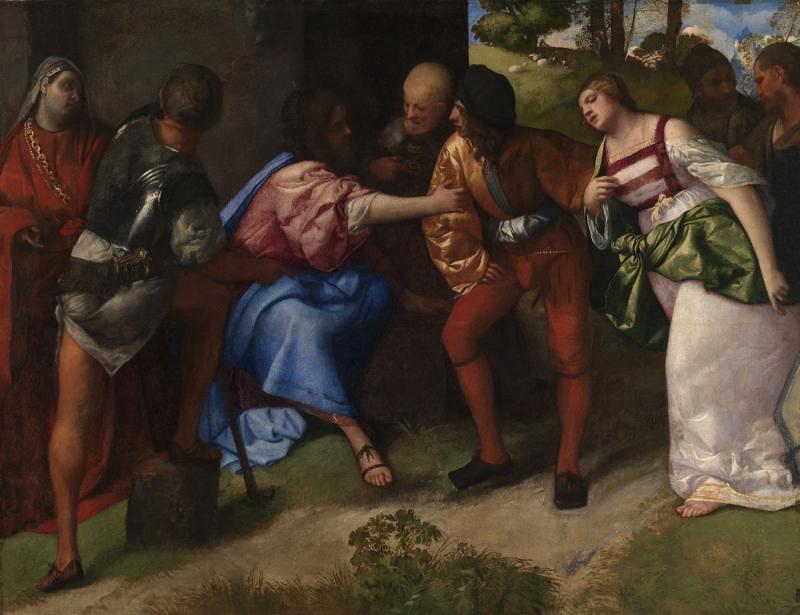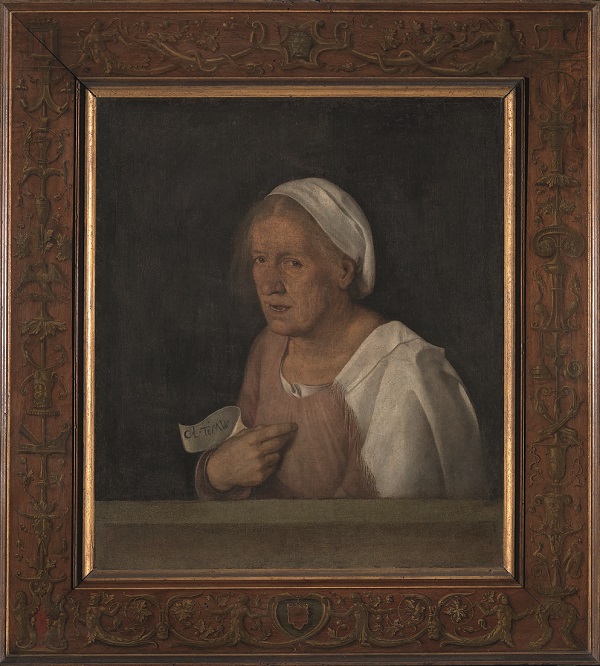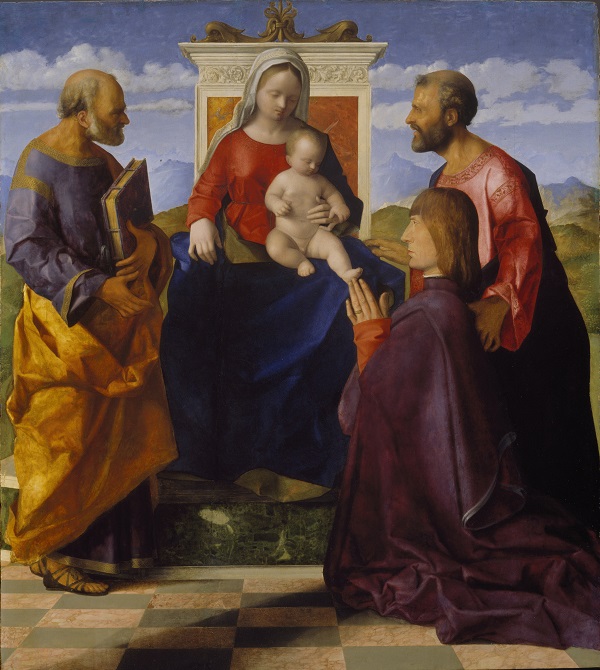In the Age of Giorgione, Royal Academy | reviews, news & interviews
In the Age of Giorgione, Royal Academy
In the Age of Giorgione, Royal Academy
A tantalising evocation of 16th-century Venice, but the great painter remains elusive

Much is made of the mystery surrounding Giorgione, a painter of pivotal influence, about whom, paradoxically, we know almost nothing beyond the manner of his death. He died in a Venetian plague colony in 1510 aged about 33, and was as elusive in the 16th century as he is today, his paintings highly sought after but hard to come by, and by the time of his death already invested with mythic status.
So little is known of Giorgione’s biography, and yet he was such a huge influence on the next generation of Venetian artists – notably Titian – that his work has often been indistinguishable from that of the circle of artists who would become synonymous with the achievements of 16th-century Venice. The exhibition claims to address the topic of attribution that inevitably arises, but glosses over the serious uncertainty attached to paintings billed not just as “attributed to” but “by” Giorgione. One of the stars of the show, La Vecchia (pictured below right), is often said to depict Giorgione’s elderly mother, but the message in her hand, “Col Tempo” (With Time), and the urgency with which she seeks our gaze makes it principally allegorical, a warning that age comes to us all. It is labelled as if Giorgione’s authorship is unequivocal, and you would need to read the catalogue to discover the painting’s contested status.
 Similarly the Terris Portrait, thought to date from 1506, is an uncannily immediate painting that subjects the viewer to the intense gaze of a now anonymous man. Said to be by Giorgione, it has a provenance that goes back only as far as the 19th century, with certainty about its authorship resting in large part on a contemporary inscription on the back of the panel that names Giorgione as its maker.
Similarly the Terris Portrait, thought to date from 1506, is an uncannily immediate painting that subjects the viewer to the intense gaze of a now anonymous man. Said to be by Giorgione, it has a provenance that goes back only as far as the 19th century, with certainty about its authorship resting in large part on a contemporary inscription on the back of the panel that names Giorgione as its maker.
Nevertheless, the portrait gains authority because it seems exceptional, embodying some of the influences and innovations that must have made Venice a truly remarkable place at the turn of the 16th century. Giovanni Bellini, the godfather of Venetian painting was still alive, and the incredibly well-travelled Dürer was here in 1506, his fondness for landscape chiming with a new regard for landscape in Venetian painting (pictured below left: Giovanni Bellini, Virgin and Child with Saint Peter, Saint Mark and a Donor, 1505). Leonardo da Vinci had visited in 1499, his characteristic sfumato technique apparently catching on and seen here in the Terris Portrait contributing to the painting’s vitality and naturalism.
Giorgione is presented in the broadest of brushstrokes, absorbing and reinterpreting influences and bringing to portraiture and devotional imagery a drama and immediacy that would come to be a defining characteristic of Venetian painting (main picture: Titian, Christ and the Adulteress, c.1511). In keeping with his enigmatic persona, he is presented as an influence more than an actual presence, and the exhibition’s pleasingly simple, essentially linear interpretation shows a curiously old-fashioned approach to art history. Ironically, it is the paintings said to be by Giorgione himself that threaten to disrupt an otherwise neat and tidy narrative, and the astonishing variance in the physical condition of these paintings means that to treat them as works by the same hand is, at times, something of a leap of faith.
 One notable juxtaposition is of the enigmatic Portrait of an Archer, and the Portrait of a Young Man and His Servant (both undated). Both are attributed to Giorgione and yet the comparison is bewildering, the poor but surely authentically 16th-century condition of the archer jarring with the brilliant, clean colours of the other, a painting that has evidently been cleaned, possibly rather enthusiastically, in the not so distant past.
One notable juxtaposition is of the enigmatic Portrait of an Archer, and the Portrait of a Young Man and His Servant (both undated). Both are attributed to Giorgione and yet the comparison is bewildering, the poor but surely authentically 16th-century condition of the archer jarring with the brilliant, clean colours of the other, a painting that has evidently been cleaned, possibly rather enthusiastically, in the not so distant past.
Paintings are all inevitably in variable states of repair; condition is dependent on many factors, from artists’ technique to the often complicated life stories that have ensured their survival for, in Giorgione’s case, some 500 years, not to mention the conservation policies of the institutions that now care for them. What is beyond dispute is that in the case of Giorgione, many of the works attributed to him are hard to reconcile with one another. Whether this is due to different conservation histories or, ultimately, different authors is a question that can only exacerbate the difficulties faced by scholars trying to establish a secure oeuvre for Giorgione. On this note, the late arrival of the Three Ages of Man, c.1500, due at the end of March following conservation treatment, should be anticipated with equal measures of excitement and trepidation.
rating
Explore topics
Share this article
The future of Arts Journalism
You can stop theartsdesk.com closing!
We urgently need financing to survive. Our fundraising drive has thus far raised £49,000 but we need to reach £100,000 or we will be forced to close. Please contribute here: https://gofund.me/c3f6033d
And if you can forward this information to anyone who might assist, we’d be grateful.

Subscribe to theartsdesk.com
Thank you for continuing to read our work on theartsdesk.com. For unlimited access to every article in its entirety, including our archive of more than 15,000 pieces, we're asking for £5 per month or £40 per year. We feel it's a very good deal, and hope you do too.
To take a subscription now simply click here.
And if you're looking for that extra gift for a friend or family member, why not treat them to a theartsdesk.com gift subscription?
more Visual arts
 'We are bowled over!' Thank you for your messages of love and support
Much-appreciated words of commendation from readers and the cultural community
'We are bowled over!' Thank you for your messages of love and support
Much-appreciated words of commendation from readers and the cultural community
 Folkestone Triennial 2025 - landscape, seascape, art lovers' escape
Locally rooted festival brings home many but not all global concerns
Folkestone Triennial 2025 - landscape, seascape, art lovers' escape
Locally rooted festival brings home many but not all global concerns
 Sir Brian Clarke (1953-2025) - a personal tribute
Remembering an artist with a gift for the transcendent
Sir Brian Clarke (1953-2025) - a personal tribute
Remembering an artist with a gift for the transcendent
 Emily Kam Kngwarray, Tate Modern review - glimpses of another world
Pictures that are an affirmation of belonging
Emily Kam Kngwarray, Tate Modern review - glimpses of another world
Pictures that are an affirmation of belonging
 Kiefer / Van Gogh, Royal Academy review - a pairing of opposites
Small scale intensity meets large scale melodrama
Kiefer / Van Gogh, Royal Academy review - a pairing of opposites
Small scale intensity meets large scale melodrama
 Jenny Saville: The Anatomy of Painting, National Portrait Gallery review - a protégé losing her way
A brilliant painter in search of a worthwhile subject
Jenny Saville: The Anatomy of Painting, National Portrait Gallery review - a protégé losing her way
A brilliant painter in search of a worthwhile subject
 Abstract Erotic, Courtauld Gallery review - sculpture that is sensuous, funny and subversive
Testing the boundaries of good taste, and winning
Abstract Erotic, Courtauld Gallery review - sculpture that is sensuous, funny and subversive
Testing the boundaries of good taste, and winning
 Edward Burra, Tate Britain review - watercolour made mainstream
Social satire with a nasty bite
Edward Burra, Tate Britain review - watercolour made mainstream
Social satire with a nasty bite
 Ithell Colquhoun, Tate Britain review - revelations of a weird and wonderful world
Emanations from the unconscious
Ithell Colquhoun, Tate Britain review - revelations of a weird and wonderful world
Emanations from the unconscious
 Rachel Jones: Gated Canyons, Dulwich Picture Gallery review - teeth with a real bite
Mouths have never looked so good
Rachel Jones: Gated Canyons, Dulwich Picture Gallery review - teeth with a real bite
Mouths have never looked so good
 Yoshitomo Nara, Hayward Gallery review - sickeningly cute kids
How to make millions out of kitsch
Yoshitomo Nara, Hayward Gallery review - sickeningly cute kids
How to make millions out of kitsch
 Hamad Butt: Apprehensions, Whitechapel Gallery review - cool, calm and potentially lethal
The YBA who didn’t have time to become a household name
Hamad Butt: Apprehensions, Whitechapel Gallery review - cool, calm and potentially lethal
The YBA who didn’t have time to become a household name
